
Published on December 1st, 2021 | by Editor

Fifty years of Laser sailing
Published on December 1st, 2021 by Editor -->
When the Laser boat emerged in the 1970s, it was a gateway drug to the world of sailing. Go anywhere, launch anywhere, race anywhere. Adults and youth sailors alike, it initiated a worldwide generation that continues today.
During the pandemic in 2020, it was the solution to social distancing, with dusty gear finding the water again. And in this era of age-based youth sailing, the Laser offers inter-generational competition, bringing all ages together for learning and living.
Mark Lammens remembered when it all began, and the experience created the foundation in which his impact on Canadian sailing has been profound, earning him the Sail Canada President’s Award for his contributions to the sport.
In this report, Mark shares his 50 years of Laser sailing:

When I was 12 my parents were thinking about getting me a boat. Sailing school was fun and going well in Flying Juniors, so my dad bought the plans to build a marine plywood OK dinghy in our basement.
He was very handy and built a Snipe as our first family boat years back. At the same time. the Laser just came out and was built an hour away from where we lived. They decided to spend the $795 on a brand new red Laser, #8525. The boat was simple, affordable, and fun.
The boat came with a modern name, polypropylene traveler, mahogany blades, a 3.2 oz Elvstrom sail, and Elvstrom ratchet block. It came with a wooden tiller, a short extension, brummel hooks on a clew tie down and system ropes you would see on a keel boat. It also had high quality metal gudgeons and wooden hand rails that never broke.
That summer my instructor brought me to a regatta in Montreal with 210 Lasers. Before long, there were 20 Lasers at the club.
The concept and design came from Canadians Bruce Kirby (designer), Ian Bruce (builder), and Hans Fogh (sail and rig). All three were successful Olympic sailors and saw a need for a boat that provides simple sailing for everyone. The Laser class rules embraced the one design manufactured provided boat approach to ensure fairness in racing and simplicity, though this might have slowed down the introduction of needed improvements like an auto bailer, metal fairleads, durable sail cloth, and a better ratchet block.
The boats built back then had a wide option of colors like blue, mustard, red, and yellow. Because it was marketed as a roof topper with a 2 part non-tapered simple aluminum mast, lower top sides and 130 pound +/- weight, the Laser could be easily transported on the roof of the big cars of the time. Although there was a major uptick in singlehanded racing, the boat became very popular with the cottage community as many thousands of them were bought for the weekends on the lake. By the end of 1981, a 100,000 were built.
A big part of launching was having a friend help carry the boat in and out of the water or dragging it up the beach. Marketing the ease of transportation and storage might have delayed the introduction of a portable dolly which came later from Peter Siedenburg, a Finn sailor in Toronto who saw the need and designed the Seitech Dolly.
There was also a wide range of variables like all up weight and mast rake, and it took 15-20 years for some improvements like low profile tiller, thimbles for mechanical advantage on restricted rope systems, and better quality ropes.
The first smaller sail option was called the M rig which used the standard rig bottom section with a shorter top section with a halyard. M stood for Modified or Mini, but it was really a mistake. It was very difficult to de-power when the wind came up as the mast would not bend.
The better option was the Radial rig in 1983 with a smaller bottom section and the same top section developed by Fogh. There were many challenges with the smaller bottom section as it had to be able to bend and not break. Sleeves inside the mast and a thinner wall section seemed to help allow mast bend and also not break at deck level.
The Radial boat was ultimately named after the radial sail. The sail radiated from the clew and the sail cloth needed to stretch along with the bendy mast to have the mast/sail work together. Pulling on the downhaul to depower was hard on the sail cloth durability. A better longer lasting sail like the new standard Mark 2 sail is still an issue. Sailors that are campaigning in this class have a significant sail equipment expense.
There was another option for younger and lighter sailors, the 4.7. It was designed in 2005 with a much smaller 4.7 square meter sail with an even smaller bottom section. The bottom section has a permanent bend at deck level to ensure the sail is over top of the centerboard for steering balance.
The Class Association was committed to promoting racing, ‘Sailing is Fun’ and the new go fast techniques with the member newsletter. All sailors were new to the boat and an environment of collective improvement and sharing information was the mantra of the class.
Publications such as ‘Beam Reach’ and ‘the Laser Sailor’ had district reports, regatta results, and many tips from coaches and champions to keep the class engaged and informed.
The Laser came before the invention of many products that make sailing easier. Waterproof sunscreen, Gore-Tex, rash guards, McLube, Gatorade, no stretch non-absorbing non-tangling Rooster rope, chill guards, Zhik life jackets, and energy bars were many years away. Good hiking boots, quick dry technical clothing, merino wool, and the introduction and improvement in neoprene for hiking pants and cold water sailing was also years away.
A complicated and contentious patent, royalty, and international availability issue required a boat name change from Laser to ILCA to maintain Olympic status.
Today’s equivalent Laser boat, the ILCA 7 has a carbon fibre top section option, 4.5 oz sail, tapered battens, non-slip hiking strap, electronic compass, and properly oriented harken rigging systems that can be adjusted from hiking position. With the boat’s World Sailing international status, it has national three letter identifiers plus national flag.
In 1996, 25 years after the first boats went into production, Olympic status was awarded for the Laser, followed in 2008 for the Radial. Today the Singlehanded Men’s class at the Olympics is now the ILCA 7 and the Singlehanded Women’s class is the ILCA 6.
The simple, widely available, consistently constructed boat with a two-part mast ensures that racing is testing the ability and fitness of the sailor. As a British journalist once commented on boats, “the Laser (ILCA) is a proper little yacht.”
Perhaps in light of that the class would consider bringing back metal gudgeons, hand rails that don’t break, and design a new longer lasting sail for the Women.

Tags: ILCA , Mark Lammens
Related Posts
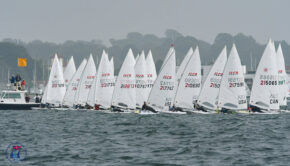
Love letter from the back of the fleet →
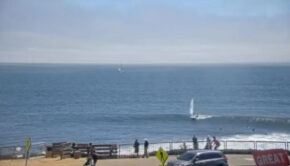
VIDEO: ILCA surfing at Steamer Lane →
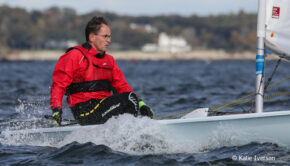
PHOTOS: Fall racing in Marblehead →
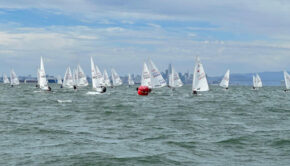
ILCA Masters U.S. Championship →
© 2024 Scuttlebutt Sailing News. Inbox Communications, Inc. All Rights Reserved. made by VSSL Agency .
- Privacy Statement
- Advertise With Us
Get Your Sailing News Fix!
Your download by email.
- Your Name...
- Your Email... *
- Name This field is for validation purposes and should be left unchanged.

Great choice! Your favorites are temporarily saved for this session. Sign in to save them permanently, access them on any device, and receive relevant alerts.
- Sailboat Guide
Laser 2 is a 14 ′ 5 ″ / 4.4 m monohull sailboat designed by Bethwaite Design and Ian Bruce and built by Performance Sailcraft between 1978 and 1987.
Rig and Sails
Auxilary power, accomodations, calculations.
The theoretical maximum speed that a displacement hull can move efficiently through the water is determined by it's waterline length and displacement. It may be unable to reach this speed if the boat is underpowered or heavily loaded, though it may exceed this speed given enough power. Read more.
Classic hull speed formula:
Hull Speed = 1.34 x √LWL
Max Speed/Length ratio = 8.26 ÷ Displacement/Length ratio .311 Hull Speed = Max Speed/Length ratio x √LWL
Sail Area / Displacement Ratio
A measure of the power of the sails relative to the weight of the boat. The higher the number, the higher the performance, but the harder the boat will be to handle. This ratio is a "non-dimensional" value that facilitates comparisons between boats of different types and sizes. Read more.
SA/D = SA ÷ (D ÷ 64) 2/3
- SA : Sail area in square feet, derived by adding the mainsail area to 100% of the foretriangle area (the lateral area above the deck between the mast and the forestay).
- D : Displacement in pounds.
Ballast / Displacement Ratio
A measure of the stability of a boat's hull that suggests how well a monohull will stand up to its sails. The ballast displacement ratio indicates how much of the weight of a boat is placed for maximum stability against capsizing and is an indicator of stiffness and resistance to capsize.
Ballast / Displacement * 100
Displacement / Length Ratio
A measure of the weight of the boat relative to it's length at the waterline. The higher a boat’s D/L ratio, the more easily it will carry a load and the more comfortable its motion will be. The lower a boat's ratio is, the less power it takes to drive the boat to its nominal hull speed or beyond. Read more.
D/L = (D ÷ 2240) ÷ (0.01 x LWL)³
- D: Displacement of the boat in pounds.
- LWL: Waterline length in feet
Comfort Ratio
This ratio assess how quickly and abruptly a boat’s hull reacts to waves in a significant seaway, these being the elements of a boat’s motion most likely to cause seasickness. Read more.
Comfort ratio = D ÷ (.65 x (.7 LWL + .3 LOA) x Beam 1.33 )
- D: Displacement of the boat in pounds
- LOA: Length overall in feet
- Beam: Width of boat at the widest point in feet
Capsize Screening Formula
This formula attempts to indicate whether a given boat might be too wide and light to readily right itself after being overturned in extreme conditions. Read more.
CSV = Beam ÷ ³√(D / 64)
Thanks to Ken H. for contributing drawing scanned from orginal brochure. The LASER 2 has a convoluted history. There was the LASER II FUN, and the LASER II REGATTA, a LASER FUN NEW WAVE, (which added an assym. spinnaker). All retired before 1990.
Embed this page on your own website by copying and pasting this code.
- About Sailboat Guide
©2024 Sea Time Tech, LLC
This site is protected by reCAPTCHA and the Google Privacy Policy and Terms of Service apply.
The Laser 28 is a 28.41ft fractional sloop designed by Bruce Farr and built in fiberglass by Performance Sailcraft between 1983 and 1990.
The Laser 28 is a light sailboat which is a very high performer. It is stable / stiff and has a low righting capability if capsized. It is best suited as a racing boat.
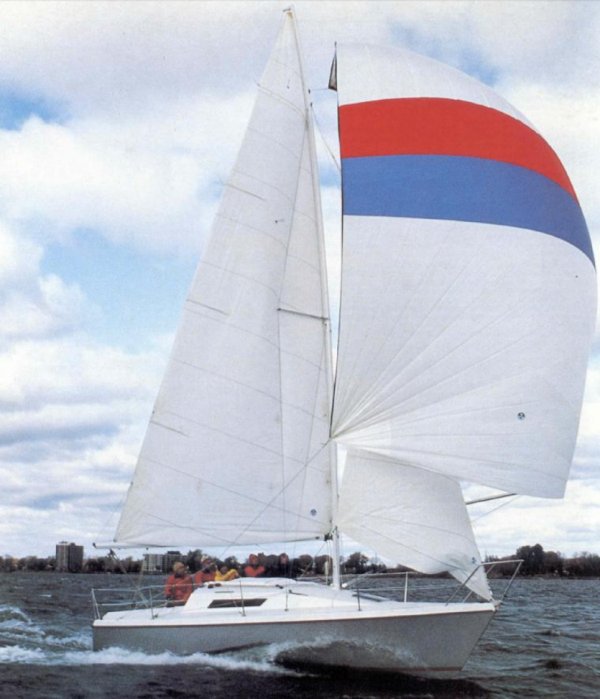
Laser 28 for sale elsewhere on the web:

Main features
Login or register to personnalize this screen.
You will be able to pin external links of your choice.

See how Sailboatlab works in video

We help you build your own hydraulic steering system - Lecomble & Schmitt
Accommodations
Builder data, other photos.
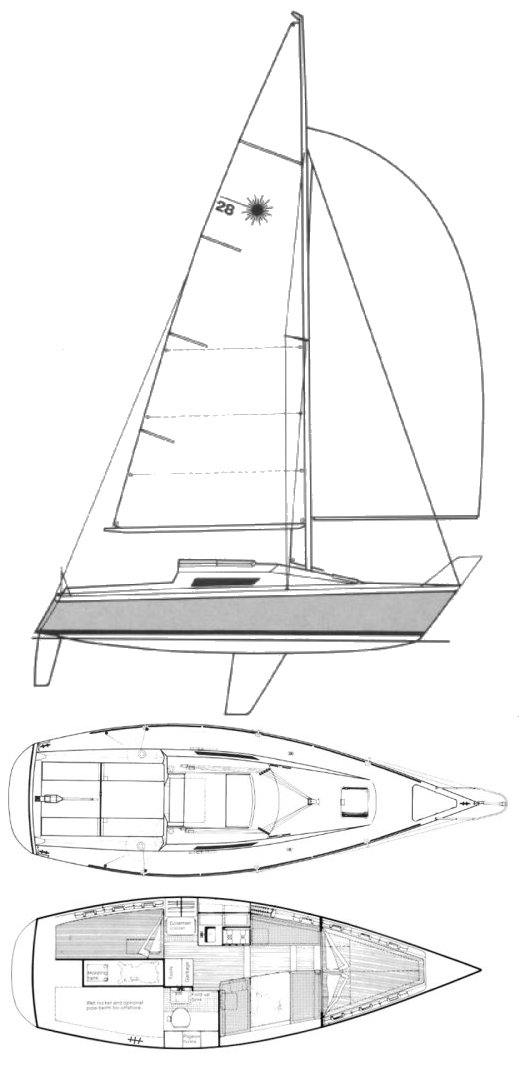
Modal Title
The content of your modal.
Personalize your sailboat data sheet
Your cart is empty
Have an account?
Log in to check out faster.
Best Sellers

ILCA (Laser) Sailing 101
What is the ilca (laser) class.
Note: In this article, the terms "Laser" and "ILCA" are going to be used interchangeably. Worldwide, the class is now officially known as the ILCA, despite originally being called the Laser .
The Laser class is a one design dinghy originally designed by Bruce Kirby and Ian Bruce in 1969. Although the original intent behind the design was a recreational, family-friendly boat, the Laser has gone on to become one of the most popular racing boats in the world, with over 220,000 produced.

What makes up a boat?
Being a one design and Olympic class, all Laser boats conform strictly to the Laser class rules. In order to compete at continental and international championships, you will need to ensure that your equipment is ILCA class certified, and complies with the measurement standards set out by the class. There is a number of non-class legal equipment available, and if you're just planning on sailing for fun, these are a great option for getting started. (Hint: google Intensity Sails)
A relatively lightweight hull for its size, the Laser is 4.23m long, has a beam of 1.42m and weights 57kg. All hulls are built from glass reinforced plastic (AKA fibreglass) and are known for their robust construction and light weight.
One of the unique features of the Laser class is the three different rigs which can all be used with the same hull. This allows sailors of different ages, weights and abilities to participate in a single class. The rigs are:
Laser Standard (ILCA 7)
Laser Radial (ILCA 6)
Laser 4.7 (ILCA 4)
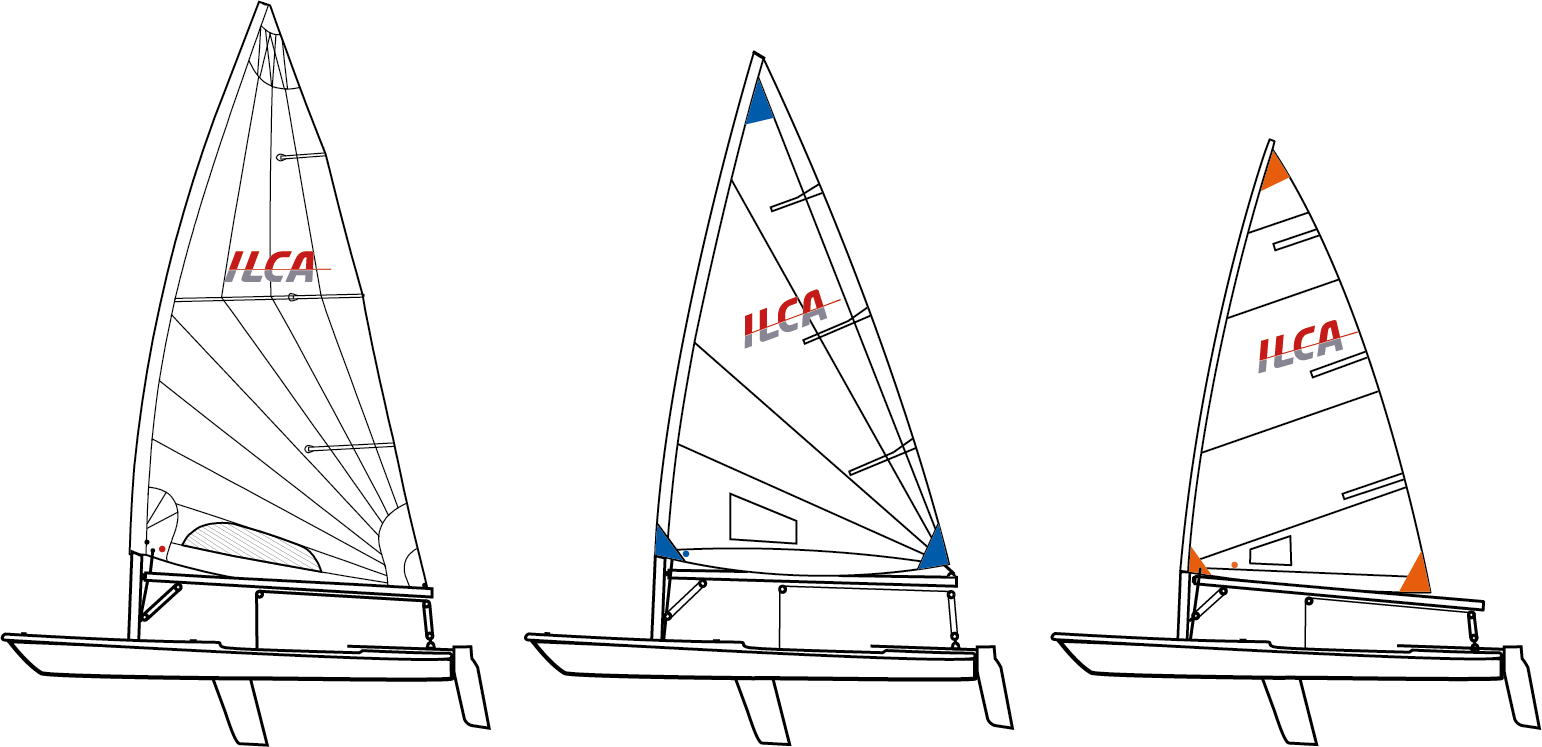
Masts/Spars
Each Laser rig consists of three pieces - the bottom mast, top mast and boom. The bottom mast is specific to each rig size, but the same top section and boom can be used with all three rigs.
Similar to the bottom mast sections, each Laser rig also has its own sail, and they are all different sizes.
Control Lines and Rigging
In the early 2000s, the class introduced the Turbo Kit rigging, which made a significant difference in the techniques and ease of sailing the boat. Although the Turbo rigging is standard nowadays, the old systems can still be found, and can be used to race.
One thing that many sailors like about the Laser is the speed and simplicity of its rigging. The boat has only four main control lines: the mainsheet, vang (kicker), cunningham and outhaul.
Similar to the hull, ILCA foils are also made from fibreglass. The centreboard (daggerboard) is inserted in to the case aft of the mast step, and the rudder clips easily on to the gudgeons on the transom of the hull.
Accessories
Launching trolley - unless you will be beaching (not recommended) or storing your boat on a dock, you will need a trolley to launch your boat. Most boats are sold with these.
Road Trailer - if you would like to sail at different venues, or compete away from home, one of the easiest ways to transport your boat is with a road trailer. The Laser was originally designed to be loaded on to the roof of a car, and if you would like to find out more about transportation methods, we have a full article here .
Tiller and Extension - these come in both aluminium and carbon varieties, and both can be used to race.
Clothing - you can wear anything while sailing the Laser, but I would recommend getting at least a life jacket (better safe than sorry), and a pair of hiking pants. Hiking pants will protect the back of your legs from the deck, and allow you to sail for longer.
Who Can Sail the Laser?
Another great things to mention about the Laser is the range of uses and abilities the boat caters to. Lasers can be sailed on the weekend with your family for fun, or raced in the Olympics and everything in between!
What is the optimal weight for the Laser?
Thanks to the three rig sizes in the Laser class, the weight range in the Laser is quite large. Generally, the Laser Radial (ILCA 6) is suitable for sailors between 60kg and 75kg while the Laser Standard (ILCA 7) is suitable for sailors 75kg to over 90kg. The Laser 4.7 (ILCA 4) is designed specifically for younger and lighter sailors with an optimal weight range between 45kg - 60kg.
What ages are the sailors?
Laser sailing is a sport you can do for life, and nearly every Laser regatta there will be an age category catering to everyone from junior sailors through to master ages. Generally the age categories are U19, Open (20-35), and Masters (over 35). Depending on the regatta, there may also be additional age divisions including U17, and U15. It’s never too late to start sailing a Laser!
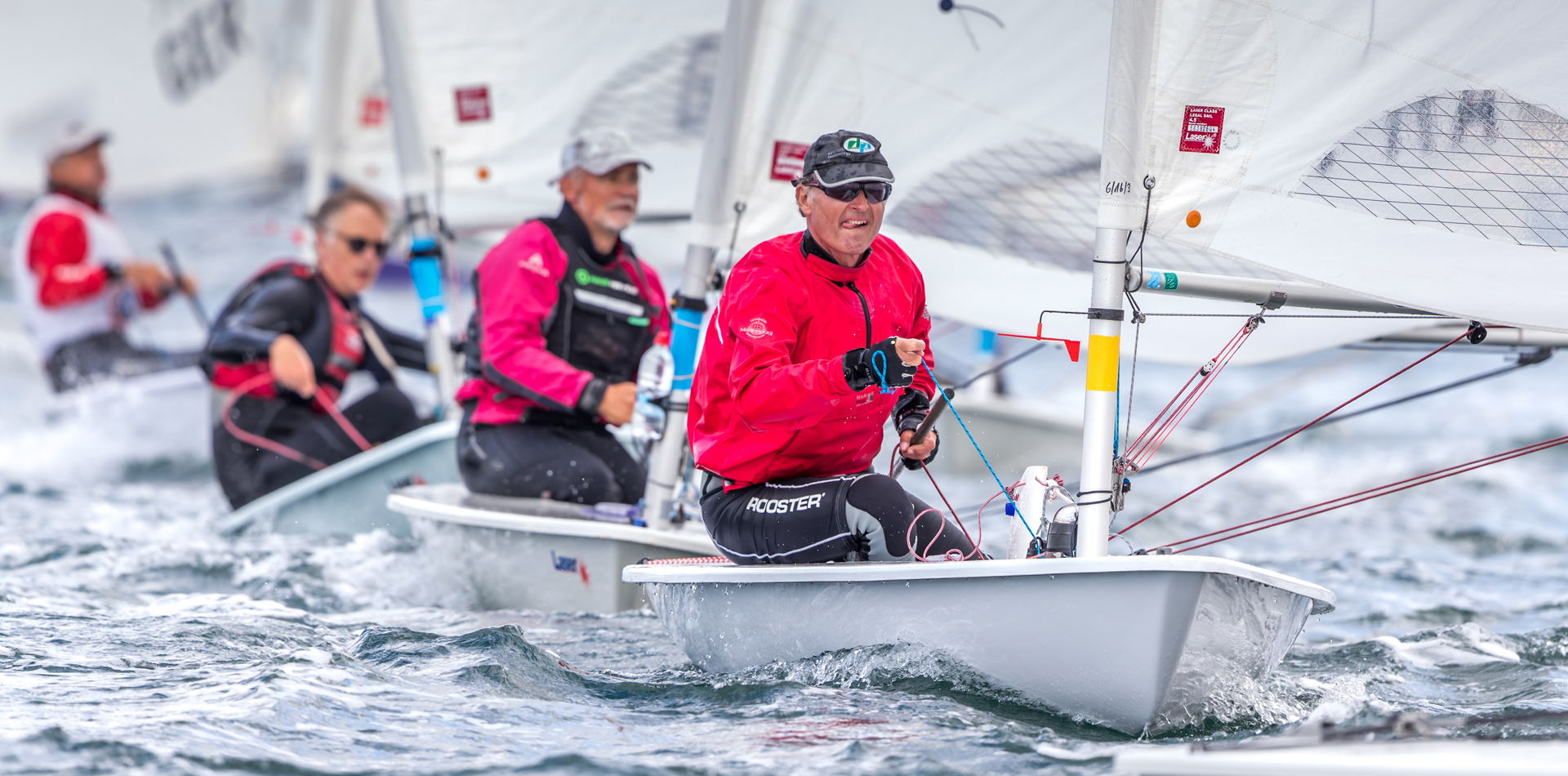
Where to Sail a Laser?
The Laser world is divided in to 6 different regions:
North America
Central and South America
Rest of World
with each region comprising of various member countries and districts. Being the most popular dinghy class in the world, there are Lasers in over 120 countries around the world, and it's likely there is a sailing club with at least one boat near you. For more information and contact details for an association in your country, ILCA have a directory of ILCA District Contacts .
Laser Racing
Since the inception of the class, the Laser has been considered one of the world's premiere racing classes thanks to its low-cost, availability and one design nature providing tight competition at all levels. Since 1996, Laser racing has been included at the Olympics, and many Olympic laser sailors have gone on to the pinnacles of high performance sailing. If you want to see the calibre of some of the sailors who have competed in the Laser, be sure to check out our ranking of the Top 10 Male Sailors and Top 10 Female Sailors of all time.

Outside of the Olympics, the ILCA class also organises World Championships for all rigs and age divisions on a yearly basis. These include the following regattas:
Masters World Championship (all divisions and rigs)
U21 World Championship (ILCA 6 and ILCA 7)
ILCA 4 Youth World Championship
ILCA 6 Women's World Championship
ILCA 6 Youth World Championship
ILCA 6 Men's World Championship
ILCA 7 Men's World Championship.
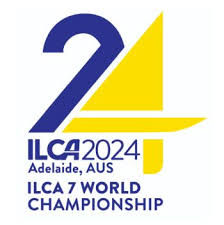
The full list and dates of upcoming ILCA World Championships can be found on the ILCA website .
Each ILCA region also hosts their own continental championships, and these also have a typically high attendance, and strong calibre of racing. The list of championships for each of the regions can be found here:
Oceania (out of date)
Starting Out with ILCA Sailing
If you're now feeling ready and excited to kick off your Laser journey, here's some things you might want to know before getting on the water
Getting a Boat
Due to their popularity, nearly every sailing club around the world will have at least one Laser lying around which you could try out before you buy your own boat. Many clubs also have rental programs where you can borrow or lease their boats for a minimal cost. This is a great way to get started and see if you enjoy the class.
If however, you're already at the point where you want to get your own boat, there will also be plenty of second hand boats which you could consider upgrading to. If you want some advice on looking for a used Laser, we have a complete second hand Laser Buyer's Guide .
Alternatively, I may have done such a good job convincing you to start ILCA sailing that you're ready to throw yourself in to it headfirst and buy a new boat. If that's the case, contact me at daniel.self@sail27 .com and I can help you find the best boat for you, or connect you with a great Laser dealer in your area.
Training and Coaching
Regardless of your ability, getting a coach is going to help you improve your sailing and much faster than you would by yourself. There are plenty of ILCA coaches all around the world, and the best resource I have found for finding a coach is ILCA's Coach directory . Another great option is to talk to your local sailing club or ILCA district association - they're sure to know someone in your area who can help you get started in the class.
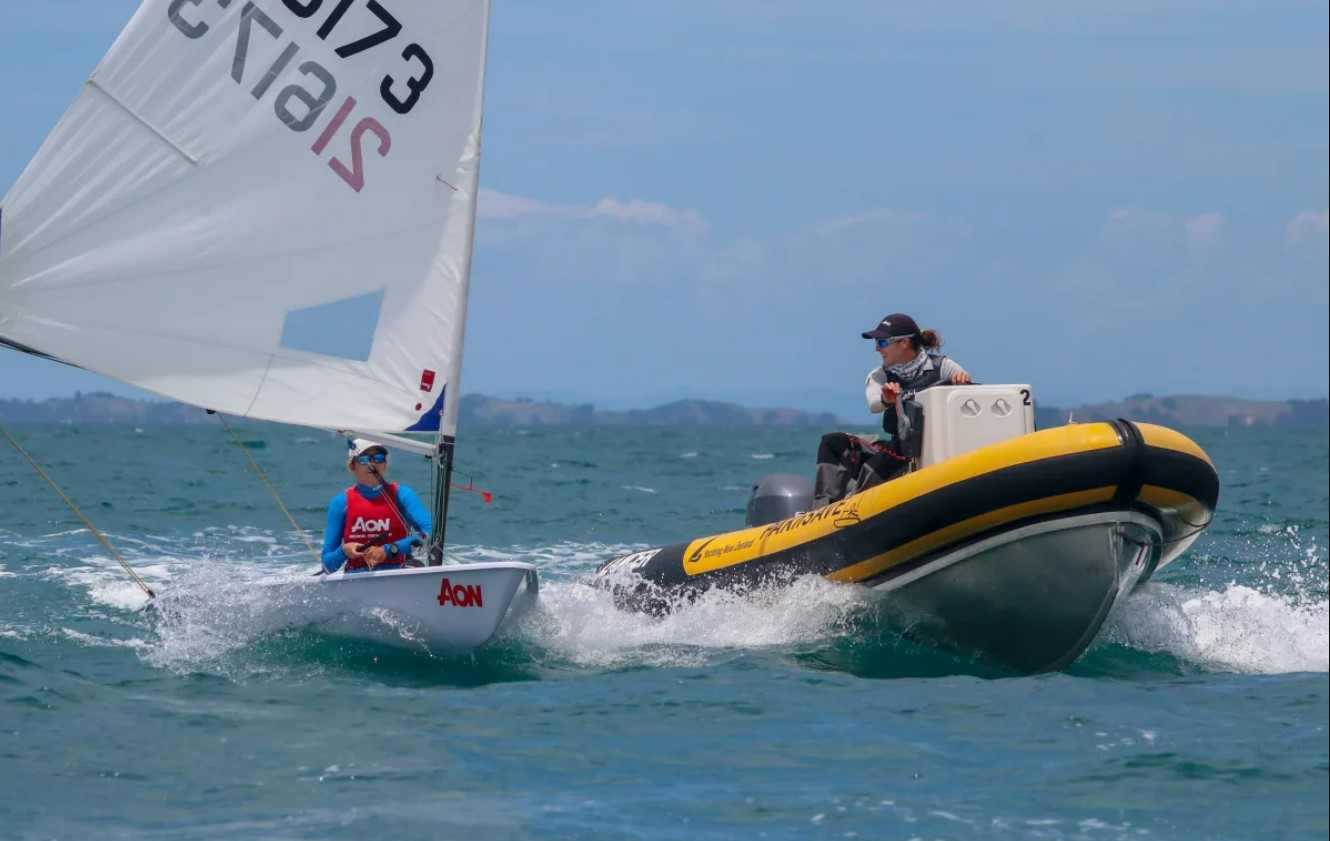
Since the COVID pandemic, online Laser coaching has become more accessible, and the guys at the International Sailing Academy have some great courses which can help you get from an intermediate to advanced Laser sailor.
You may however still be more of a 'book person' (that's how I started as well). If that's the case, I would recommend the RYA Laser Handbook. Although its a little older now, this is the most comprehensive guide to Laser sailing that I've read. Even as I got further in to my sailing journey, I would often refer back to this book for new tips.
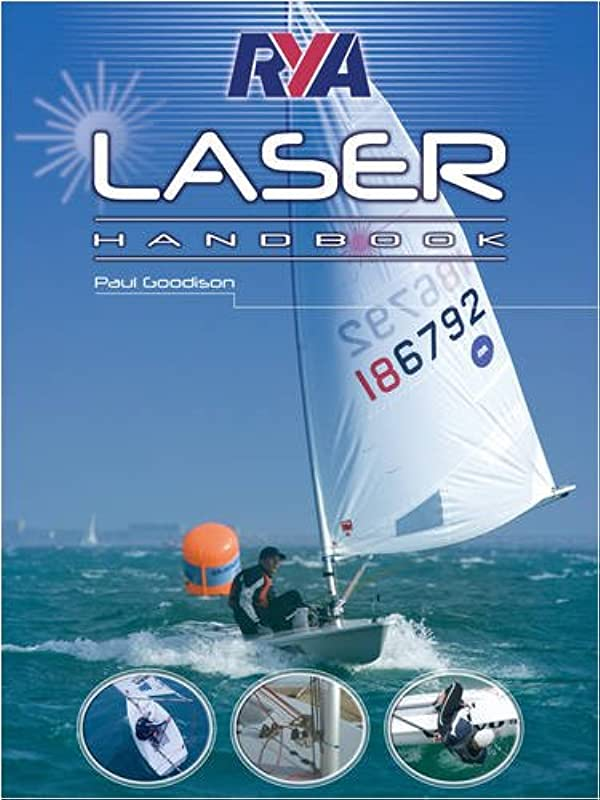
Wrapping Up
With all of that information, you should now be well versed on the ILCA class, and how you can get started in it. If you need any further information, feel free to comment below and I'll try to answer as well as possible. Otherwise, happy sailing and I'll see you on the water sometime soon!
Leave a comment
Please note, comments need to be approved before they are published.
- Choosing a selection results in a full page refresh.
- Opens in a new window.
Sailboat specifications
- Last update: 3rd April 2020
Laser 5000's main features
Laser 5000's main dimensions, laser 5000's rig and sails, laser 5000's performances, laser 5000's auxiliary engine, laser 5000's accommodations and layout.

Similar sailboats that may interest you:

How Much Does A Laser Sailboat Cost? New vs Old

The cost of a laser sailboat can vary. It’s just like buying a car, you half to shop around for the best deal.
A Laser sailboat new will cost anywhere from $5000 to $6000. A used Laser sailboat will cost you between $2000 and $6000. The price of the boat will depend on the year it was built and the condition it is in.
Buying a laser is a fairly simple process. Since they are so small it is much easier to transport. A lot of them do come with trailers, but some do not. Just be sure you have a way to move it when needed. The laser is 14 feet long. To help compare to a truck, a long bed truck is usually 8 feet.
If you really want to save some money, you should look all over the country. I can find some good deals on laser sailboats right now, but they are about three states away. If you are willing to drive to the boat and pick it up, you could save a thousand bucks or two.
Purchasing A Laser Sailboat
If you have decided to get into laser sailing, you will need a boat. The question is do you buy used or new? That will depend on your budget and possibly, your intended use. The intended use will either be racing, recreational, or both. The good thing is, as long as the boat is well kept and In good condition, it will work for both options.
When it comes to buying a used laser, there are a few things you need to check.
The first thing to check is the hull. Make sure it is solid and has no holes or soft spots. The next thing to check is to see if it comes with everything you need. I once was given a laser boat, but it was just the hull and nothing else. I actually ended up selling it. It was not a project I wanted to take on. I wish I had it today though.
When purchasing a used laser, you may be asking how old it is.
How Old Is My Laser Sailboat? Complete List
The list above should help you identify the year of your laser sailboat. If the number is not on this list it must be much older.
The Parts Of A Laser Sailboat
The laser has a few different parts that you need to know about.
First, we have the mast. The mast is a two-part mast that can be adjusted depending on the size of the sail you are using. It gets set into the mast step, which is a hole in the hull where the mast goes.
Second, we have the sails. There are 3 different sizes of sails you can use on your laser. The size will depend on your weight. You need to have good balance for the laser sailboat and sail size will help accomplish this. The three sails are listed below:
3 Laser Sail Types
- Standard Sail – sail size 7.06 meters, crew size 154lbs +
- Radial Sail – sail size 5.76 meters, crew size 121-154lbs
- 4.7 Sail (smallest) – sail size 4.7 meters, crew size 77-121lbs
You can also use the smaller sails for high winds. Each sail will also contain 3 battens.
Battens aren’t necessary, but they do help support the leech. To find out more about battens read the article Can You Sail Without Battens?
The third is the daggerboard. The daggerboard goes down through a slot in the hull. You put it all the way down for upwind, up for downwind, and middle for reaching. The daggerboard is a type of keel.
Fourth is the rudder. the rudder will be down when sailing and needs to be kept tight. If it kicks up on you, you will lose the ability to steer the boat.
The fifth part of the boat is the boom. You will not be able to use your sails without the boom. It is very similar looking to the mast. Just make sure when you purchase your boat, that you have both the mast and the boom.
The sixth and final part you need is the tiller. The tiller is what controls your rudder and allows you to steer the boat. You will also want a tiller extender. The extender will allow you to control the boat when leaning out over the high side for balance.
Those 6 parts are the most necessary components to check for when purchasing a laser sailboat. You will also need the lines for raising and lowering sails, but I’m sure you know about those.
My Final Thoughts About The Laser Sailboat

The laser sailboat is a lot of fun for beginners and experienced sailors. They are fairly cheap and easy to use. There is a part of balance required to use them, but it should come pretty easy with some practice. I would love to own a laser, but at this time I do not. They are great for racing as well. If you want to go fast and love competition, I highly recommend a laser sailboat. I hope this article helped answer some of your laser questions and if you have more, please reach out to us! Cheers!

Boatlifehq owner and author/editor of this article.
Recent Posts
Sailboat Racing - Rules & Regulations Explained
Sailboat racing, a blend of skill, strategy, and adherence to intricate rules and regulations, offers a thrilling and intellectually stimulating experience on the water. Navigating through the...
What is the best sailboat to live on? Complete Guide
Embarking on the journey of living aboard a sailboat requires careful consideration of your budget, desired amenities, and storage options. This guide offers a concise, step-by-step approach to...
× You are using an outdated browser. Please upgrade your browser to improve your experience.
We Ship Worldwide! | FREE SHIPPING! for US Continental orders over $99. Click for details.

Shopping Cart
Your cart is currently empty..
FREE SHIPPING! for US Continental orders over $99 click for details
Laser - Sailboat Data, Parts & Rigging
Sailboat data directory for sailboats manufacturer or named Laser. Follow the provided links for additional sailboat data, parts and rigging specs.
Sailboat Data directory for over 8,000 sailboat designs and manufacturers. Direct access to halyards lengths, recommended sail areas, mainsail cover styles, standing rigging fittings, and lots more for all cruising and racing sailboats.
MAURIPRO Sailing offers a full range of sailboat and sailing information to help you find the correct sailboat part, one that properly would fit your sailboat and sailing style. Our sailor's and sailboat owner support team are ready to talk with you about your specific sailing needs, coming regatta, or next sailing adventure.
From all at MAURIPRO, let's Go Sailing!
Copyright © 2024 MAURIPRO Sailing LLC.

IMAGES
COMMENTS
A boat with a BN of 1.6 or greater is a boat that will be reefed often in offshore cruising. Derek Harvey, "Multihulls for Cruising and Racing", International Marine, Camden, Maine, 1991, states that a BN of 1 is generally accepted as the dividing line between so-called slow and fast multihulls.
The Laser is the world's most popular adult racing class boat. True to box one design standards, each Laser in the world is identical ensuring the best sailor on the water wins the race, not the boat. The Laser is a challenging boat that rewards athleticism, subtle steering and trimming techniques, as well as the tactical excellence of the sailor.
Laser (dinghy) The Laser is a class of single-handed, one-design sailing dinghies using a common hull design with three interchangeable rigs of different sail areas, appropriate to a given combination of wind strength and crew weight. Ian Bruce and Bruce Kirby designed the Laser in 1970 with an emphasis on simplicity and performance.
Homepage - LaserPerformance. The Cascais is the ultimate rotomolded multi-purpose sailing dinghy. Its versatility and innovative design brings together exceptional handling, speed and stability allied with its spacious cockpit and 3 rig/ sail versions makes this the ideal platform for all levels of sailors. We believe that rotomolded boats ...
Laser (International) is a 13′ 8″ / 4.2 m monohull sailboat designed by Bruce Kirby and Ian Bruce and built by Performance Sailcraft and LaserPerformance starting in 1970. ... the more easily it will carry a load and the more comfortable its motion will be. The lower a boat's ratio is, the less power it takes to drive the boat to its ...
The Laser is a true sailing phenomenon. With nearly 200,000 boats in 140 countries, it is clearly the world's most popular adult and youth racing sailboat. Each year the Laser Class runs more races worldwide than any other class. And it's still going strong! For almost four decades, the Laser has been a sailing success story.
The Laser sb3 is a 20.18ft fractional sloop designed by Tony Castro and built in fiberglass by Dart Sailboats since 2004. The Laser sb3 is a light sailboat which is a very high performer. It is very stable / stiff and has a low righting capability if capsized. It is best suited as a racing boat.
This is the most common Laser rig size, and the original rig on the boat when it was designed. It features a 7.06 square meter sail (about 76 square feet). In 2018, the Laser Class approved a new 'Standard' sail, which is referred to as the 'MKII' or 'Mark 2' to distinguish it from the first version. The difference, among other things, is in ...
Over 200,000 Laser sailboats have been built over the last 40 years, more than most other small dinghy sailboats. In this article we are going to answer some of the common questions we receive about the basics of Laser sailboat rigging, how to tell what size rig you have, what you can upgrade, and more. This information is designed for the ...
Introduction to Laser Sailing. The Laser is truly the boat for all ages from our Junior 4.7s to our legendary (over 75 year old) Masters. No other adult class is raced in more countries in the World, in a class which takes grass roots to Olympic sailors. Come and join us to see why!
Fifty years of Laser sailing. Published on December 1st, 2021. When the Laser boat emerged in the 1970s, it was a gateway drug to the world of sailing. Go anywhere, launch anywhere, race anywhere ...
Laser 2 is a 14′ 5″ / 4.4 m monohull sailboat designed by Bethwaite Design and Ian Bruce and built by Performance Sailcraft between 1978 and 1987. ... the more easily it will carry a load and the more comfortable its motion will be. The lower a boat's ratio is, the less power it takes to drive the boat to its nominal hull speed or beyond ...
The Laser 28 is a 28.41ft fractional sloop designed by Bruce Farr and built in fiberglass by Performance Sailcraft between 1983 and 1990. The Laser 28 is a light sailboat which is a very high performer. It is stable / stiff and has a low righting capability if capsized. It is best suited as a racing boat.
Thanks to the three rig sizes in the Laser class, the weight range in the Laser is quite large. Generally, the Laser Radial (ILCA 6) is suitable for sailors between 60kg and 75kg while the Laser Standard (ILCA 7) is suitable for sailors 75kg to over 90kg. The Laser 4.7 (ILCA 4) is designed specifically for younger and lighter sailors with an ...
The LASER 2 has a convoluted history. There was the LASER II FUN, and the LASER II REGATTA, a LASER FUN NEW WAVE, (which added an assym. spinnaker). All retired before 1990. ... A Ballast/Displacement ratio of 40 or more translates into a stiffer, more powerful boat that will be better able to stand up to the wind. Bal./Disp = ballast (lbs ...
Laser 5000 Sailboat specifications. Last update: 3rd April 2020. The Laser 5000 is a 16'5" (5m) double handed skiff (dinghy) ... i Portsmouth Yardstick is an empirical rating system allowing small sailboats (dinghies included), of different sizes and designs, to race each other fairly. Therefore, by comparing these values, we can have an ...
Laser Main Sail Kit. Tiller Cover Kit - Standard Sunbrella® Color. Throated Sail Cover Kit - Standard Sunbrella® Color (Booms to 10') Sail Pack Kit - Standard Sunbrella® Color (10' Boom) Complete Sail Plan Data for the Laser Sail Data. Sailrite offers free rig and sail dimensions with featured products and canvas kits that fit the boat.
It's just like buying a car, you half to shop around for the best deal. A Laser sailboat new will cost anywhere from $5000 to $6000. A used Laser sailboat will cost you between $2000 and $6000. The price of the boat will depend on the year it was built and the condition it is in. Buying a laser is a fairly simple process.
SailboatData.com …is a database that contains information on over 9000 production and semi-production sailboats dating back to the late 1800's. COMPARE BOATS To compare up to three boats at one time, click the (+) Remove a compared boat by clicking (-)
Designed for single and double handed sailing. AKA PICO. Also available is the LASER PICO RACE (shown in photo), an upgraded version of the LASER PICO. It features a larger Mylar mainsail, a vang with 4:1 purchase and upgraded blocks.
A Ballast/Displacement ratio of 40 or more translates into a stiffer, more powerful boat that will be better able to stand up to the wind. Bal./Disp = ballast (lbs)/ displacement (lbs)*100 Disp./Len.: The lower a boat's Displacement/Length (LWL) ratio, the less power it takes to drive the boat to its nominal hull speed. less than 100 ...
Sailboat Data directory for over 8,000 sailboat designs and manufacturers. Direct access to halyards lengths, recommended sail areas, mainsail cover styles, standing rigging fittings, and lots more for all cruising and racing sailboats. MAURIPRO Sailing offers a full range of sailboat and sailing information to help you find the correct ...
LaserPerformance north america. 300 Highpoint Avenue. Portsmouth, Rhode Island 02871. USA. t +1 800 966 SAIL. f +1 401 683 0990. LaserPerformance europe. Station Works, Long Buckby. Northamptonshire NN6 7PF.